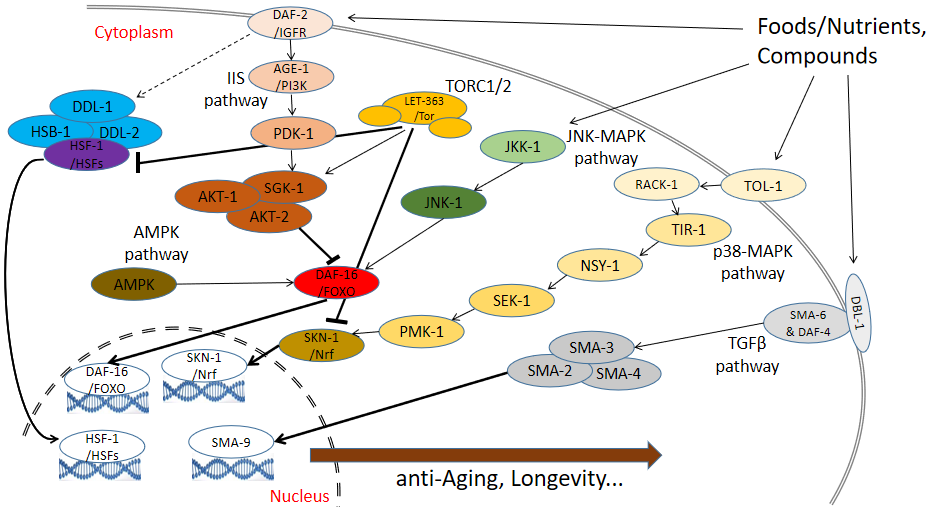Anti-aging Drug Screening
Aging is a natural process characterized by the gradual decline of homeostatic mechanisms, which is also a key risk factor for many age-related diseases. Studies have shown that manipulating multiple key pathways can slow down the aging process and delay the onset of related diseases (Figure 1). Therefore, identifying compounds (or natural compounds) with life-extending, anti-aggregation and antioxidant properties has become a focus of anti-aging research. However, traditional drug studies in mammals are costly and time-intensive, making efficient screening models essential.

Figure 1 Conserved pathways of aging in nematodes
Why C. elegans?
C. elegans offers unique advantages for anti-aging research
• Genetic Homology: Shares 40%-60% of human genes.
• Short Lifespan: A complete life cycle in 2-3 weeks.
• Ease of Use: Small size, transparent body, and easy cultivation.
These features make C. elegans an ideal tool for understanding the aging process and anti-aging drug discovery.
Our Services
We provide C. elegans Anti-Aging Drug Screening Service to quickly test the efficacy of potential anti-aging drugs. By assessing the lifespan, health status, antioxidant capacity, and aging markers, we can provide critical data for your anti-aging drugs research.
Our service supports:
• Aging research
• exploration of aging mechanisms
• Anti-aging drug screening
• Development of healthy aging-related products.
Whether in the drug discovery stage or on the basis of aging research, this service can provide efficient and reliable experimental support for your scientific research projects, helping you discover and verify potential anti-aging drugs and accelerate the development of treatment plans for aging-related diseases.
Our anti-aging drug screening process includes:
1. Synchronized Culture of C. elegans
synchronized C. elegans were cultured on nematode culture plates containing E. coli OP50.
2. Compound Library Preparation
We work to build a compound library of natural compounds, synthetic chemicals or drug candidates based on specific screening criteria.
3. Drug Exposure
C. elegans at a specific growth stage are exposed to the compound based on the throughput needs. For example, liquid exposure is used for high throughput screening of a large number of compounds; solid agar exposure suits low throughput screening of a small number of compounds.
4. Phenotypic Analysis
After drug exposure, we will conduct a comprehensive assessment and analysis of its lifespan and health status. Detailed phenotyping services include motility, lipofuscin levels, and pharyngeal pump contraction frequency, with tailored solution available for specific requirements.
Related Services
H001-Food clearance assay
H002-Fecundity assay
H003-Body length measurement
H004-Pharyngeal pumping assay
H005-Head thrashes assay
H006-Body bending assay
H007-Lifespan assay
H012-lipofuscin measurement assay
H029


